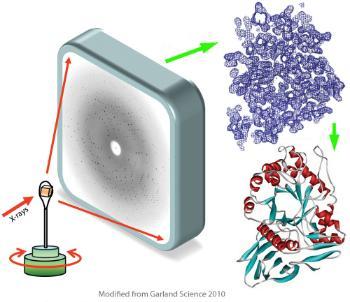X-ray crystallography
 X-ray crystallography can be used to determine the 3D structure of proteins. The process begins with trying to produce well-ordered single crystals of the protein of interest that are large enough to diffract X-rays to high resolution and then to be able to go on and solve their 3D structure. The availability of a protein structure can provide a more detailed focus for future research. The extension of the technique to systems such as protein–nucleic complexes, viruses and immune complexes serves only to widen the appeal of crystallography. Structure based drug design, elucidation of enzyme mechanisms, site directed mutagenesis and specificity of protein–ligand interactions are just a few of the areas in which x-ray crystallography can be applied.
X-ray crystallography can be used to determine the 3D structure of proteins. The process begins with trying to produce well-ordered single crystals of the protein of interest that are large enough to diffract X-rays to high resolution and then to be able to go on and solve their 3D structure. The availability of a protein structure can provide a more detailed focus for future research. The extension of the technique to systems such as protein–nucleic complexes, viruses and immune complexes serves only to widen the appeal of crystallography. Structure based drug design, elucidation of enzyme mechanisms, site directed mutagenesis and specificity of protein–ligand interactions are just a few of the areas in which x-ray crystallography can be applied.
Here in Glasgow with the use of a variety of commercial sparse matric screens, coupled with the use of crystallisation robots, we can efficiently test for initial crystallisations conditions that can be optimised to produce diffracting quality crystals. We collect data at synchrotron facilities.
For project discussions contact Dr. Mads Gabrielsen.


